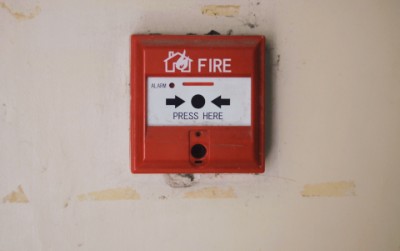Fire Safety in the Workplace: A Guide

Estimated reading time: 9 minutes
Introduction
Following the requirements for fire safety in the workplace can be confusing and intimidating. In the UK, all non-domestic premises are broadly covered by the Regulatory Reform (Fire Safety) Order 2005. In this document we summarise some of the common causes of workplace fires as well as the consequences, then go on to outline who is responsible for workplace fire safety and offer some tips on how to implement fire safety best practices in your non-domestic premises.
Common causes of fire in the workplace
To understand the reasons behind the legislation, let’s first explore why office fires start. Here’s some of the most common causes:
Faulty wiring and electrical issues
Probably the most common cause of office fires, faulty, old and/or misused electricals often the catalyst.
In the typical UK office, for example, it’s not uncommon to see an overloaded plug socket with extensions and no proper surge protection. People are busy throughout the work day and lack the constant awareness necessary for proper fire safety and may not realise the danger they are putting themselves and others in. In these cases, it’s also evident that staff may lack proper fire safety training.
We don’t consider the office a dangerous place, as it shouldn’t be. If an office is functioning without incident, we think that it will continue to do so and don’t undertake periodic structural reviews. Many office buildings, consequently, suffer from unseen ageing and degradation, making an evaluation of electrical wiring and installations a ‘crucial safety matter’.
Both overloaded plug sockets and old, faulty wiring suffer the same issue; they heat up and are unable to conduct electricity properly. This heat is one of the components of the fire triangle, vital to igniting a fire.

Cooking equipment and small appliances
Kettles, microwaves and other small kitchen appliances are electrical items which allegedly causes 29% of workplace fires.
Cooking equipment and other workplace appliances cause so many incidents for two main reasons, both of which stem from neglect. The first is outright misuse, stemming from a lack of time and care for work property. Many office kitchens are just that; small spaces with improper ventilation and inadequate space for kitchen use. Consequently, fridges and microwaves have little room to vent, toasters aren’t cleaned and kettles are overworked (particularly in the UK).
Moreover, these appliances are often old and untested. When you join a new workplace, you don’t question how old the kettle is – no-one does! As a result, many workspaces have a range of small appliances which aren’t PAT-tested and could have been there for years.
Arson
Unfortunately, arson is still a threat to fire safety in the workplace. As recently as 2019/20, 13% of all office fires were deliberate.
Often these fires are started by a disgruntled former employee or by the business owner themselves in an attempt to make a fraudulent insurance claim.
Flammable Materials
It’s important to note that you don’t have to stock rocket fuel onsite for your workplace to be full of combustible materials. Offices have a number of common flammable materials easily at hand, including stacks of paper, wooden desks and cardboard boxes. One can easily imagine how an overloaded plug socket next to a pile of printer paper could spell disaster.
Furthermore, combustible materials left accessible near the premises or in unlocked waste bins can be easy fuel for arsonists.
What are the consequences of workplace fires?
The human cost
Fortunately, the casualty rate for office fires is low. Many companies take their responsibilities seriously by complying wholeheartedly with UK office safety laws. As a result, the fire signage, equipment and evacuation procedures which they invest in keep their staff and premises safe.
Of course, this is not always the case and in 2019/20, there were still 16 casualties in the UK from workplace fires. Whilst this may seem low, no-one should expect to get injured in a fire incident at work; the office should be a place of calm and safety.
The financial cost
The financial cost of a workplace fires is huge. In 2004 alone, the overall cost of UK office fires to the British economy was estimated at £2.5 billion.
Primarily, there can be high reconstruction costs; the office building would likely have suffered structural damage and major assets could have been lost. Moreover, lost productivity can have a major impact on a business, with some offices out of commission for months or even permanently. Even if employees can work remotely, the psychological impact of the fire can hinder their work rate and increase their reluctance to return to work.

What’s more, fines for negligence can cause bankruptcy. Business owners in the UK have paid anywhere from £20,000 to £400,000 in fines, as New Look found out in 2007. The judge found the company guilty on the basis of damage to other high street stores, blockage of exit routes and, most importantly, a significant lack of staff training in fire safety.
The Regulatory Reform (Fire Safety Order) 2005
Following the UK’s legislation on non-domestic fire safety consists of following two core steps.
Your team must first designate the Responsible Person. This refers to anyone with some ‘control of the premises’ and often includes:
- Employers
- Business/Facility Managers
- Occupants
- Business Owners
- Professional Risk Assessor
There can be more than one Responsible Person. If there are a number of people with control over the premises, fire safety becomes a team effort. Once this person(s) is appointed, they have a number of key tasks to follow:
- Complete a Fire Risk Assessment
- Communicate the risks found
- Create a set of fire safety measures and implement them
- Provide formal fire safety training to all staff members, thus fulfilling your legal obligation
- Plan emergency evacuation procedures
Who enforces this legislation?
The local fire authority, typically fire services personnel, is responsible for enforcing fire safety in the workplace.
All UK workplaces must permit inspection from these authorities at any time. Consequences of negligence found in this inspection can be:
- Alterations, enforcement and prohibition notices. These letters from the enforcing authority require immediate change at one end of the spectrum and can close the workplace at the other.
- Fines and imprisonment. The authorities can issue unlimited fines and, should the case go to criminal court, can send you to prison for up to 2 years.
Implementing the Legislation
The role of the Responsible Person is loosely defined as someone with ‘control over the premises’. If there are multiple people with such control, they must meet and work as a team to decide who the Responsible Person(s) is.
If your premises is one of a group under the same business, then your organisation should designate a Responsible Person at each level. There should be a Responsible Person at board, area and premises level.
Fire Risk Assessment
Whomever the responsible person or people may be, they must first lead a fire risk assessment:
- Identify fire hazards.
- Understand who is at risk on the premises.
- Reduce risks and remove them where possible.
- Keep thorough records, prepare your evacuation procedures and offer formal fire safety training to all staff.
- Review this assessment periodically.
Note that a ‘competent person’ should be the one to complete your assessment. This is typically the Responsible Person and they must have a thorough knowledge of the fire safety procedures required specifically by your office.
Areas to think about
All offices are different. An accountant’s office could be beneath a flat or in a skyscraper; you could have an office of 5 or 500. As a result, each risk assessment needs to be tailored to the individual business. Below, however, there are a few areas to think about when undertaking your fire risk assessment.
Consider the ‘unlikely’
Don’t be caught off-guard by the apparent safety of your workplace. What possible sources of fuel could you have missed? There are a host of flammable materials in the office: wooden furniture, stationery, shredded paper, cleaning products, solvents and paints are just a few. Think of the everyday possibilities.
Think about those most at risk
How can you help cater for your employees with disabilities? There is a whole host of equipment designed to cater for people with disabilities during fire, including evacuation chairs and strobe or vibration smoke alarms.
Technically temporary workers and customers or clients on your premises may also be at higher risk. You can’t guarantee that they’ve received formal fire safety training so how can you help them in the event of a fire? Do you have fire notices detailing required actions? You should train your employees adequately so that, if the time comes, they could help anyone without the necessary knowledge to escape the building.
Install your legally-mandated fire warning system
In offices with more than one floor, you must have a sophisticated fire detection system in place. Whilst this doesn’t have to be a smoke alarm system, that’s the best option. Not only does it more than fulfil your legal requirement, it creates a clear communication system between all office departments in the event of fire.

Keep the correct fire equipment
Stocking the correct fire extinguisher and other fire fighting miscellany listed in your fire risk assessment is key. If your assessment correctly predicts an electrical fire, you must have a CO2 extinguisher to hand. Using a water-based fire extinguisher, in this case, can actually make the situation far worse.
Understand the schedule of your office
Though unlikely, offices can be multi-use; in the night-time, community groups or other businesses may utilise your space. Would these alternate occupants know how to follow your fire procedures or do you need to contact and educate them? Understanding exactly who uses the office is vital here, so organise yourself well and keep good records.
Day-to-Day Fire Safety in the Workplace
Finally, here’s a handful of simple ways you can manage office fire safety on a daily basis:
- Have regular office fire drills. Ensure that everyone knows their assembly points and fire evacuation procedures. Make everyone aware of a pre-scheduled drill and record the outcome.
- Don’t block fire safety routes and fire doors. Especially on a hot day, keep fire doors closed. Keep desks, other furniture, stock and rubbish out of the way of escape routes.
- Stick to your fire risk assessment. If you list certain equipment, stock and maintain it. If you have a maximum occupancy, ensure that you limit entrants to the building. Remember why you made the assessment!
Conclusion
Fire Safety in the Workplace doesn’t have to be complicated and, provided you stay on top of it, nor should it be intimidating. Stay organised and follow the legislation; it’s designed to help you. Hopefully this guide has gone some way to clarifying anything you might have been uncertain about. Good luck!
